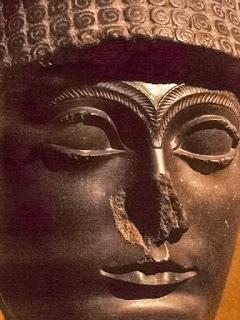The Getty Villa has reopened and is now hosting the special exhibit "Mesopotamia: Civilization Begins." Some of the objects are from the Metropolitan Museum of Art in New York. Others are on loan from The Louvre and the Bibliothèque Nationale de France. Ancient Mesopotamia, centered in present-day Iraq, occupies a unique place in the history of human culture. It is there, around 3400–3000 BC, that all the key elements of urban civilization first appear in one place: cities with monumental infrastructure and official bureaucracies overseeing agricultural, economic, and religious activities; the earliest known system of writing; and sophisticated architecture, arts, and technologies. For some three thousand years, Mesopotamia remained the preeminent force in the Near East. In 539 BC, however, Cyrus the Great captured Babylon and incorporated Mesopotamia into the Persian Empire. Periods of Greek and Parthian rule followed, and by about AD 100 Mesopotamian culture had effectively come to an end.
 |
| Closeup of a Head of Prince Gudea, Ruler of Lagash, Neo-Sumerian 2120 BCE, Diorite, that I photographed at the Santa Barbara Museum of Art in Santa Barbara, California. The sculpture of this prince at the Getty exhibit is from the Metropolitan Museum of Art in New York. |
 |
| Elamite Head of a Ruler Iran (?) 2300-2000 BCE Arsenical copper that I photographed at the Metropolitan Museum of Art in New York. The headdress seems related to Elamite works of southwestern Iran and resembles another bronze head of the late third millennium BCE found at Nineveh. |
 |
| Although you will see a statuette of a Neo-Sumerian human-headed bull dated 2150-2000 BCE from The Louvre at the exhibit, this is an image I took of a very similar sculpture at the Metropolitan Museum of Art in New York. It is identified as Kursarikku associated with the sun god Shamash Reign of Ur-Ningirsu of Lagash 2150-2100 BCE, crafted of Serpentine. This serptentine (lizardite) sculpture is from southern Mesopotamia, probably Tello (ancient Girsu). The inscription proclaims the sculpture is dedicated to the goddess Nanshe for the life of the Sumerian ruler Ur-Ningirsu. |
 |
| Statuette of the Demon Panzuzu, Neo-Assyrian, 934-610 BCE Bronze now in the collections of The Louvre, image courtesy of the museum |
 |
| Plaque with King Gilgamesh killing the monster Humbaba, Amorite, 2000 - 1600 BCE, terracotta, now in the collections of the Louvre, image courtesy of the museum |
 |
| Statuette of a dog dedicated to the goddess Ninisina, Amorite, 1894-1866 BCE, steatite, now in the collections of The Louvre, image courtesy of the museum. |
 |
| Wall fragment with a man's head, Neo-Assyrian 850-650 BCE now in the collections of The Louvre, image courtesy of the museum. |










Comments
Post a Comment